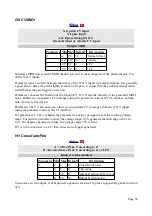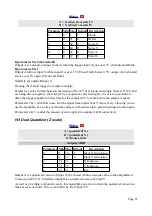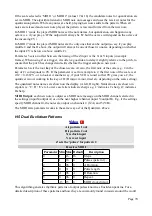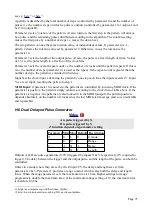
Similar to “I-4 Audio Playback with Z Speed” except that the playback speed is allowed to go
negative i.e. the sample can play backwards. Playback speed is linear with Z, with a maximum of
around 2x speed, and with 0V/center Z corresponding to a speed of zero.
Input Y selects the sample. Parameter 1 is added to input Y, so you can effectively use either or a
combination of both to select the sample. Note that in this algorithm a maximum of 50 samples are
accessible, not the usual 100.
The algorithm caches a reversed copy of each sample to the MicroSD card. It does this once only
for each sample, when it finds a new sample or one that has changed. This may take a few seconds,
during which time the message “Processing...” scrolls across the display. Do not remove the
MicroSD card or turn off the disting during this time, in case the MicroSD card becomes corrupted.
Parameters 0 & 2 are the standard sample folder and envelope time parameters, described above.
MIDI Input
: MIDI note on & off messages are handled equivalently to a trigger or gate on the X
input – that is, a note on retriggers the sample, and if the envelope time is non-zero, a note off will
stop the playback.
I-6 Audio Playback with Scrub
X is not used
Y is playback position
Z selects the sample
A is left audio output
B is right audio output
Parameter Min Max Default
Description
0
0
99
0
Folder.
1
1
99
16
Speed limit.
2
0
32
0
Slew.
3
-32 32
0
Y offset.
In this algorithm the sample playback position is directly driven from the Y input. Imagine a piece
of audio tape passing over a tape head – in other algorithms, that tape is constantly moving at some
speed or other as if driven by a motor, but in this algorithm you're basically dragging the tape back
and forwards over the playhead yourself.
Parameter 1 sets a limit on the speed at which the audio can play. With long samples or rapidly
changing Y inputs it is easy to demand very high playback speeds, and this parameter enables you
to put a cap on that.
Parameter 2 sets a slew limit, effectively putting a low-pass filter on the Y input. This is useful
particularly when using a manually-generated CV to remove any “twitchiness”.
Parameter 3 sets an offset on the Y input, essentially adding or subtracting a constant voltage.
The algorithm caches a reversed copy of each sample to the MicroSD card. It does this once only
for each sample, when it finds a new sample or one that has changed. This may take a few seconds,
during which time the message “Processing...” scrolls across the display. Do not remove the
MicroSD card or turn off the disting during this time, in case the MicroSD card becomes corrupted.
Parameter 0 is the standard sample folder parameter, described above.
Page 79






























